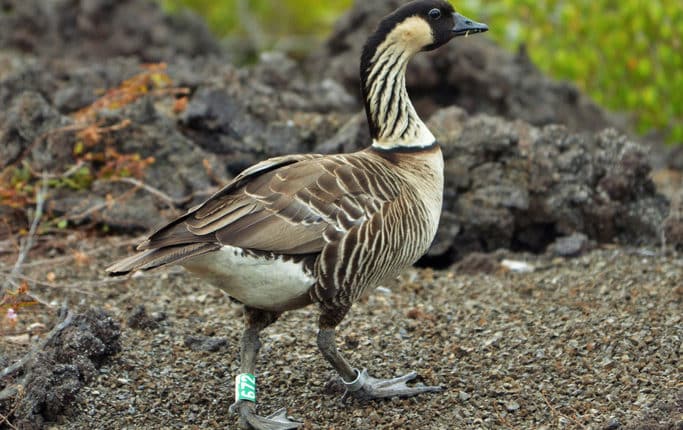The Hawaiian Goose or the “Nene” (nay-nay) is the Official Bird of Hawai’i. As an endangered species that once numbered at a mere 60, the Nene has seen a resurgence in numbers thanks to a number of conservation efforts across the islands.

The Hawaiian Goose or the “Nene” (nay-nay) is the Official Bird of Hawai’i. “Branta sandvicensis” as it is known by its scientific name, the Nene is widely believed to have evolved from Canadian geese that arrived on the islands over 500,000 years ago. Not only is the Nene the Hawaiian state bird, but it is the world’s rarest goose and its webbed feet have adapted to living on hardened lava. As an endangered species that once numbered at a mere 60, the Nene has seen a resurgence in numbers thanks to a number of conservation efforts across the islands.
Before Captain Cook’s arrival in 1778, the Nene’s population was in the tens of thousands, in part due to native Hawaiians understanding of the Nene’s breeding patterns as well as no natural predators existing on the islands. These two factors allowed these gentle birds to flourish on Hawai’i, Maui, and Kauai. But due to colonialism, the natural balance of the islands changed – large swaths of the bird’s natural habitat were deforested. Newly introduced predators, such as rats, mongooses, wild dogs, and cats, made easy meals of the helpless Nene. New settlers on the island also began hunting the Nene during the breeding season which quickly diminished the wild population. By the time it was realized that the Nene were teetering on the brink of extinction it was estimated only 60 wild geese remained on the islands.
Starting in 1950 a captive propagation program began in hopes of boosting the population. The program continues to this day and has been a success thanks to funding and restoration efforts – this once endangered bird has made a comeback. Volcanoes National Park, an original habitat for the Nene has embraced the Nene as it returns to it’s natural habitat among the rocks and lava fields where it once thrived. The Park, in large part funded by tourists visiting the area, attempts to enhance foraging habitats for wild-nesting Nene by mowing certain areas, planting native food-plants, closing breeding areas off from visitors, and supplementing food and water in safe locations among the Nene’s natural habitats.
You can catch a glimpse of these amazing creatures when you visit Volcanoes National Park, or the islands of Kauai and Maui on your next tour with Polynesian Adventure.